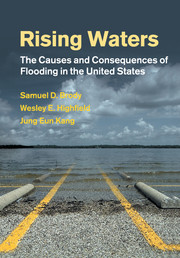Book contents
- Frontmatter
- Contents
- Preface
- Acknowledgments
- Abbreviations
- 1 Introduction: rising waters
- Part I The consequences of floods
- Part II Planning decisions and flood attenuation
- 5 Identifying the factors influencing flooding and flood damage
- 6 The role of wetlands: federal policies, losses, and floods
- 7 Mitigation strategies and reduction of flood damages
- 8 Other factors influencing flooding and flood damage
- Part III What are we learning?
- Part IV Policy implications and recommendations
- 12 Conclusions
- References
- Index
5 - Identifying the factors influencing flooding and flood damage
from Part II - Planning decisions and flood attenuation
Published online by Cambridge University Press: 28 April 2011
- Frontmatter
- Contents
- Preface
- Acknowledgments
- Abbreviations
- 1 Introduction: rising waters
- Part I The consequences of floods
- Part II Planning decisions and flood attenuation
- 5 Identifying the factors influencing flooding and flood damage
- 6 The role of wetlands: federal policies, losses, and floods
- 7 Mitigation strategies and reduction of flood damages
- 8 Other factors influencing flooding and flood damage
- Part III What are we learning?
- Part IV Policy implications and recommendations
- 12 Conclusions
- References
- Index
Summary
An important step in reducing the adverse effects of floods is first to identify the factors driving the degree of impact on human communities. Understanding the levers exacerbating or minimizing floods can help decision makers foster the development of more resilient communities. Because many of these levers are human induced (rather than purely natural acts), they can be manipulated, adjusted, or pressed on to mitigate potential damages and loss of life. The key to building flood-resistant communities, then, may be recognizing which, among multiple levers, exert the most force on the problem. The ones that can be altered through thoughtful policies and plans should be addressed first.
Some disciplines identify precipitation, slope, or stream density as the major causes of flooding; others point to population growth or land use policies as the basis for predicting flood events. In reality, the size and impact of floods is most likely a complex mix of all these characteristics and more. We assert that the only way to thoroughly understand the factors influencing flooding and flood damage is to break through single disciplines and assume a trans-disciplinary approach to modeling the problem. An interdisciplinary conceptual and quantitative model must include geophysical as well as socioeconomic and human built-environment characteristics. This approach will not only improve prediction, but represent a more holistic, and perhaps more realistic, representation of the actual problem. The end result is more precise information for those responsible for shaping coastal communities in the future.
- Type
- Chapter
- Information
- Rising WatersThe Causes and Consequences of Flooding in the United States, pp. 71 - 87Publisher: Cambridge University PressPrint publication year: 2011



